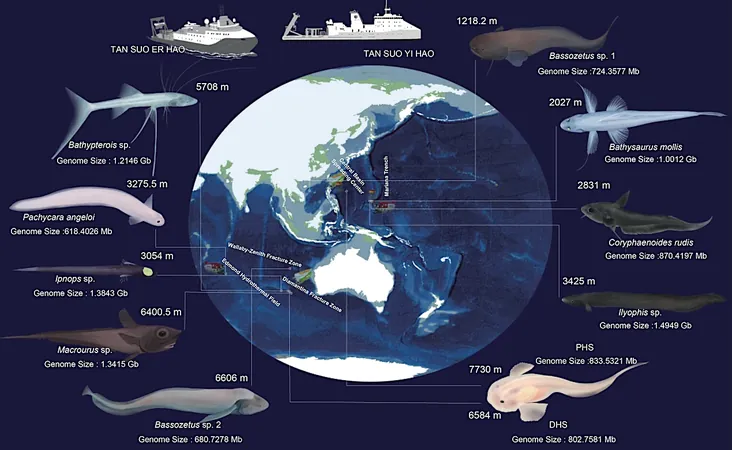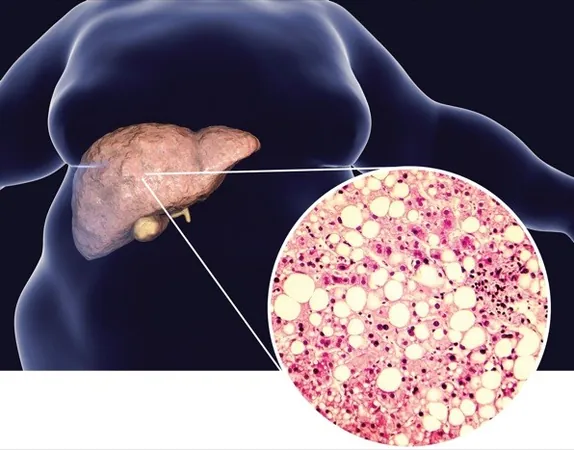
Unlocking the Secrets of the Deep: Stunning Discoveries in Ocean Biodiversity
2025-04-13
Author: Wei Ling
The Ocean's Mysteries Revealed
Covering a staggering 65% of our planet's surface, the deep sea has long been dubbed a biological desert. But recent advancements in China's deep-sea exploration have shattered this notion, uncovering a vibrant world teeming with life in its darkest depths.
A New Dawn in Hadal Exploration
In a groundbreaking study led by Prof. HE Shunping and his team at the Institute of Hydrobiology, researchers discovered that the hadal zone—found at depths exceeding 6,000 meters—is more than just an ominous abyss. It’s a cradle of evolution, home to remarkable creatures like the hadal snailfish, which not only survive but thrive in extreme conditions.
Revolutionary Research Methods
Using advanced submersibles like Shenhai Yongshi (Deep-Sea Warrior) and Fendouzhe (Striver), the team conducted extensive sampling across the western Pacific to the central Indian Ocean. Their efforts uncovered 11 unique deep-sea fish species and illuminated the evolutionary histories of these resilient creatures.
Unveiling Evolutionary Mechanisms
Published in the journal *Cell*, the findings offer new insights into how life adapts under immense pressure, low oxygen, and icy temperatures. By analyzing genetic data, researchers traced the evolutionary journey of these fish, challenging previously held theories about their adaptations.
Two Paths to Survival
The study supports a century-old hypothesis of deep-sea fish evolution, revealing two distinct pathways: the 'Ancient survivors' that adapted before the Cretaceous mass extinction, and 'new immigrants' who emerged after. This dual-pathway model reshapes our understanding of vertebrate evolution in the deep ocean.
A Surprising Twist on Adaptation
A key revelation contradicted the longstanding trimethylamine N-oxide (TMAO) adaptation theory. While TMAO levels traditionally increase with depth, researchers identified a unique mutation in the rtf1 gene among fish residing deeper than 3,000 meters, enhancing their ability to survive under extreme pressure.
Environmental Concerns Amidst Wonders
However, it wasn’t all good news. Alarmingly high concentrations of polychlorinated biphenyls (PCBs)—toxic pollutants—were found in the hadal snailfish from places like the Mariana Trench, highlighting the urgent need for environmental conservation in these almost untouched regions.
A Comprehensive Approach to Deep-Sea Research
Conducted under the Global Deep-Sea Trenches Exploration Program (Global TREnD), this groundbreaking study not only explores genetic adaptation but also sets a new interdisciplinary standard for research into deep-sea ecosystems. It paves the way for future exploration in biology and conservation efforts, underscoring the importance of protecting our ocean’s megadiversity.
The Future is Bright for Deep-Sea Exploration
As we uncover the secrets of these mysterious depths, we gain invaluable insights into the resilience of life on Earth and the hidden wonders that await in the ocean's depths. Stay tuned as scientists continue to delve into this profound frontier!



 Brasil (PT)
Brasil (PT)
 Canada (EN)
Canada (EN)
 Chile (ES)
Chile (ES)
 Česko (CS)
Česko (CS)
 대한민국 (KO)
대한민국 (KO)
 España (ES)
España (ES)
 France (FR)
France (FR)
 Hong Kong (EN)
Hong Kong (EN)
 Italia (IT)
Italia (IT)
 日本 (JA)
日本 (JA)
 Magyarország (HU)
Magyarország (HU)
 Norge (NO)
Norge (NO)
 Polska (PL)
Polska (PL)
 Schweiz (DE)
Schweiz (DE)
 Singapore (EN)
Singapore (EN)
 Sverige (SV)
Sverige (SV)
 Suomi (FI)
Suomi (FI)
 Türkiye (TR)
Türkiye (TR)
 الإمارات العربية المتحدة (AR)
الإمارات العربية المتحدة (AR)